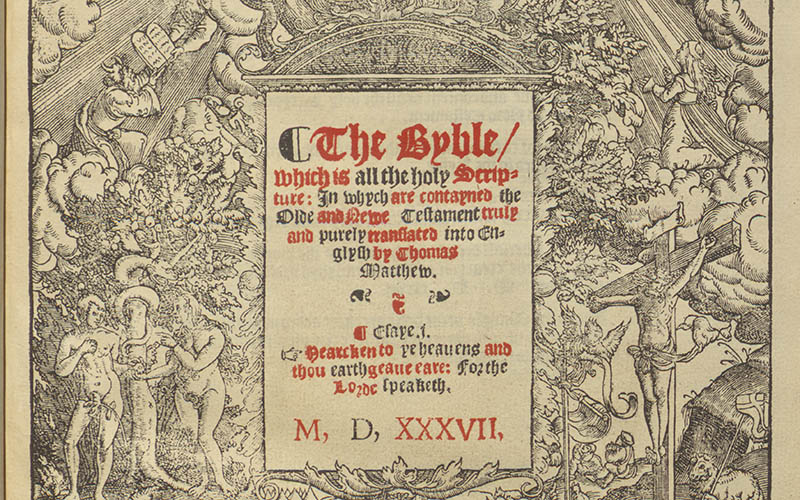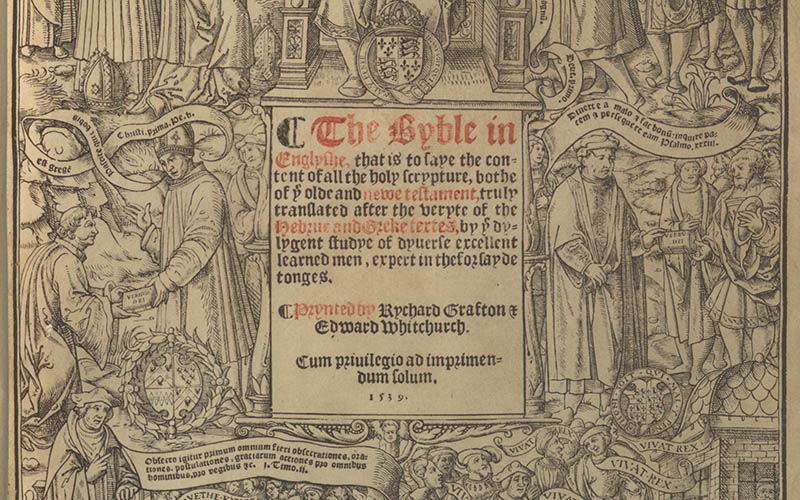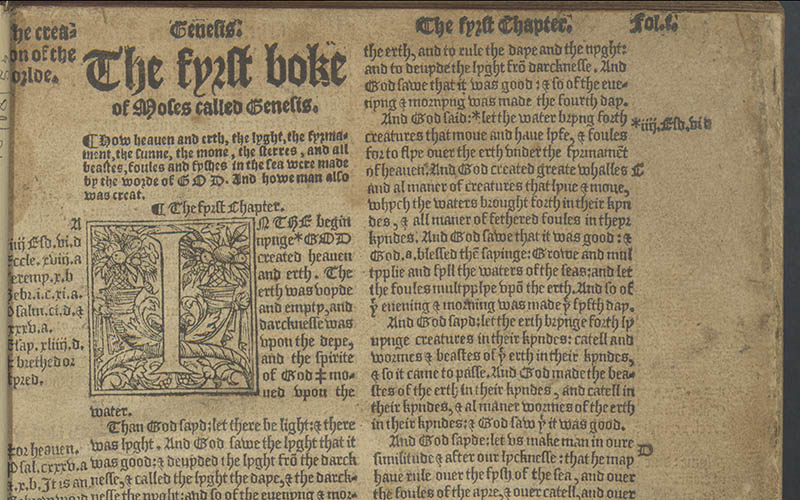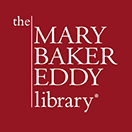
March 22, 2017
Folio. Old-style binding of pattern-stamped brown calf. Printed in black letter (Old English) Title within woodcut borders. Numerous woodcuts in the text. First edition of the Matthew Bible. Language: English

March 22, 2017
Folio. Contemporary leather binding. Title page and about nine leaves in facsimilie. Title page by Harris. Other facsimilies relating to Cranmer’s First Great Bible (1540) are laid in. Woodcut illustrations throughout. Known as “The Great Bible”. Language: English.
![La saincte Bible en francoys : translatee selon la pure et entiere traduction de Sainct Hierome : derechief conferee et entierement reuisitee selon les plus anciens & plus correctz exemplaires : ou sus vng chascun chapitre est mis brief argument : auec ce sont deux tables, dont lune est pour les diuersitez daucunes manieres de parlers figuratifz & de diuers motz qua[n]t a leur propre signification : lautre table est pour trouuuer les Epistres & Euangiles de toute lannee : auec brief recueil des ans du monde : oultre plus linterpretation daucuns noms Hebraiques, Chaldeens, Grecz, & Latins.](https://www.marybakereddylibrary.org/wp-content/uploads/2021/10/HBC_Bible_032_Featured-Image_800x500px.jpg)
March 20, 2017
Folio. Contemporary panelled calf. Lacks title page and approximately six leaves. Woodcut illustrations. Translated by Jacques Le Fèvre d’Etaples (Faber Stapulensis); his version was the first complete French translation. This volume is a reprint, with some small changes, of Le Fèvre’s 1530 edition. Known as the” Bible of Antwerp” from its place of printing. Language: French [The Holy Bible, in French…]
![The new Testament: in Englishe after the greeke translation annexed wyth the translation of Erasmus in Latin. Whereunto is added a kalendar, and an exhortation to the readyng of the holy scriptures made by the same Erasmus wyth the Epistles taken out of the olde testame[n]t both in Latin and Englyshe, whereu[n]to is added a table necessarry to finde the Epistles and Gospels for euery sonday & holyday throughout the yere after the vse of the churche of England nowe.](https://www.marybakereddylibrary.org/wp-content/uploads/2021/10/HBC_Bible_337_Featured-Image_800x500px.jpg)
March 16, 2017
Octavo. Contemporary blind-stamped brown polished calf with owner’s initials and crest on covers and brass clasps. Title page missing. Fourth edition of Tyndale’s New Testament. Language: English

March 15, 2017
Small quarto. Old vellum. Lacks title page. “Known as ‘Matthew’s version’….Thomas Matthew is commonly treated as a pseudonym of John Rogers (1500?-1550), Tindale’s intimate friend….But as Rogers only edited what is essentially Tindale’s translation, it seems more probable that Matthew stands for Tindale’s own name, which it was then dangerous to employ….Rogers’ own share in the work was probably confined to…the general task of editing the materials at his disposal.” – Historical Catalogue of the Printed Editions of Holy Scripture in the Library of the British and Foreign Bible Society, Vol. I. Language: English



![La saincte Bible en francoys : translatee selon la pure et entiere traduction de Sainct Hierome : derechief conferee et entierement reuisitee selon les plus anciens & plus correctz exemplaires : ou sus vng chascun chapitre est mis brief argument : auec ce sont deux tables, dont lune est pour les diuersitez daucunes manieres de parlers figuratifz & de diuers motz qua[n]t a leur propre signification : lautre table est pour trouuuer les Epistres & Euangiles de toute lannee : auec brief recueil des ans du monde : oultre plus linterpretation daucuns noms Hebraiques, Chaldeens, Grecz, & Latins.](https://www.marybakereddylibrary.org/wp-content/uploads/2021/10/HBC_Bible_032_Featured-Image_800x500px.jpg)
![The new Testament: in Englishe after the greeke translation annexed wyth the translation of Erasmus in Latin. Whereunto is added a kalendar, and an exhortation to the readyng of the holy scriptures made by the same Erasmus wyth the Epistles taken out of the olde testame[n]t both in Latin and Englyshe, whereu[n]to is added a table necessarry to finde the Epistles and Gospels for euery sonday & holyday throughout the yere after the vse of the churche of England nowe.](https://www.marybakereddylibrary.org/wp-content/uploads/2021/10/HBC_Bible_337_Featured-Image_800x500px.jpg)
